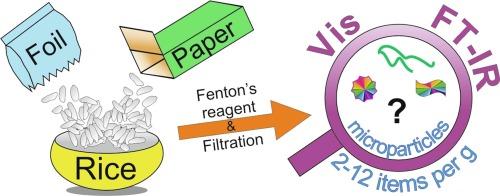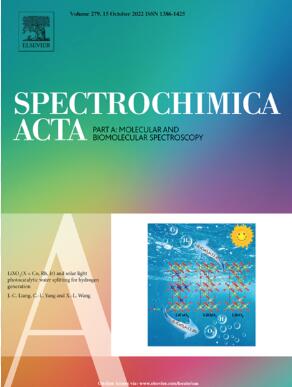商品大米污染塑料与非塑料微粒鉴别的筛选方法
IF 4.3
2区 化学
Q1 SPECTROSCOPY
Spectrochimica Acta Part A: Molecular and Biomolecular Spectroscopy
Pub Date : 2024-11-29
DOI:10.1016/j.saa.2024.125496
引用次数: 0
摘要
本文介绍了一种基于光学显微镜和傅里叶变换红外光谱的简单低成本筛选方法,用于评估水稻中发现的微颗粒。来自欧盟(EU)和非欧盟地区的五个品牌用纸和铝箔袋包装的大米进行了测试。无论大米的包装类型和产地如何,在大米中都发现了各种形状的微粒。微颗粒的含量因样品而异,从每1克大米2个到12个不等。总的来说,用铝箔袋包装的大米中微粒的丰度较高。并不是所有鉴定出的微粒都是微塑料,但那些是微塑料的微粒不能直接与大米包装的成分联系起来。对于旨在区分非塑料微粒(即大米、纸张或纤维素)与微塑料的红外光谱的粗略分析,仅分析2800 cm−1以上的吸收带就足够了。本文章由计算机程序翻译,如有差异,请以英文原文为准。

Screening method for differentiation of plastic and non-plastic microparticles contaminating store-bought rice
This article presents a simple and low-cost screening method based on optical microscopy and FT-IR spectroscopy for assessing microparticles found in rice. Five brands of rice packed in paper and foil bags from both the European Union (EU) and non-EU region were tested. Microparticles of various shapes have been found in the rice regardless of the packaging type and origin of the rice. The content of microparticles varies depending on the sample, from 2 to even 12 items per 1 g of rice. Overall, the abundance of microparticles is higher in the case of rice packed in foil bags. Not all identified microparticles are microplastics, but those that are microplastics cannot be directly linked to the composition of the rice package. For a cursory analysis aimed at distinguishing the infrared spectra of non-plastic microparticles (i.e. rice, paper or cellulose) from microplastics, it is sufficient only to analyse the absorption bands above 2800 cm−1.
求助全文
通过发布文献求助,成功后即可免费获取论文全文。
去求助
来源期刊
CiteScore
8.40
自引率
11.40%
发文量
1364
审稿时长
40 days
期刊介绍:
Spectrochimica Acta, Part A: Molecular and Biomolecular Spectroscopy (SAA) is an interdisciplinary journal which spans from basic to applied aspects of optical spectroscopy in chemistry, medicine, biology, and materials science.
The journal publishes original scientific papers that feature high-quality spectroscopic data and analysis. From the broad range of optical spectroscopies, the emphasis is on electronic, vibrational or rotational spectra of molecules, rather than on spectroscopy based on magnetic moments.
Criteria for publication in SAA are novelty, uniqueness, and outstanding quality. Routine applications of spectroscopic techniques and computational methods are not appropriate.
Topics of particular interest of Spectrochimica Acta Part A include, but are not limited to:
Spectroscopy and dynamics of bioanalytical, biomedical, environmental, and atmospheric sciences,
Novel experimental techniques or instrumentation for molecular spectroscopy,
Novel theoretical and computational methods,
Novel applications in photochemistry and photobiology,
Novel interpretational approaches as well as advances in data analysis based on electronic or vibrational spectroscopy.

 求助内容:
求助内容: 应助结果提醒方式:
应助结果提醒方式:


